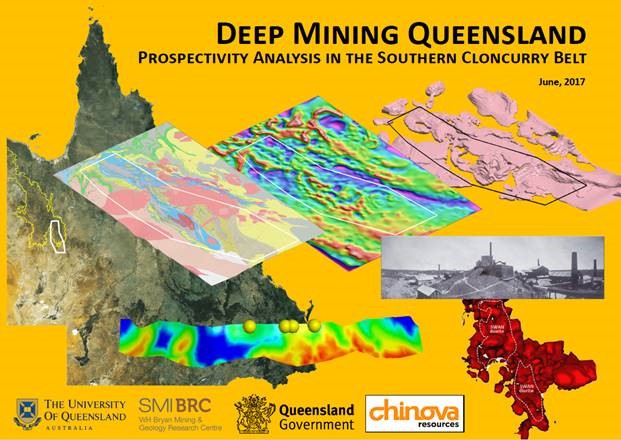Deep Mining Queensland
The Deep Mining Queensland (DMQ) Project comprised a two-year multi-disciplinary research effort aimed at reducing the risk of deep exploration for Cu-Au deposits in the Cloncurry metallogenic province.
The DMQ project was staged as follows:
- Review of characteristics of Iron-Oxide Copper Gold (IOCG) provinces and deposits, globally
- Evaluation and updating of the 2D and 3D geology of the Cloncurry Project area
- Analysis of the geological controls on deposit location and formation in the context of the new geological model
- Development of a 3D prospectivity analysis utilising the interpreted controls on deposit-formation
- Development of an evaluation tool for explorers to assess the potential relative value (future viability) of prospects and targets.
IOCG deposits are characteristically enigmatic, however, at a global-scale, common characteristics are recognized at the camp-scale and deposit-scale; despite different host-rocks and structural history. Synchronicity with voluminous felsic magmatism, regional-scale alteration systems, and localization in sites of late, brittle reactivation of earlier deformation features; are some of the key observations which then focussed analysis of the Cloncurry district.
New insights into the litho-structural development of the Cloncurry mineral-field have been made which lace existing deposits into broader geological context, finds commonality between the diverse deposit forms and host-rocks, and have been used to guide 3D prospectivity workflows.
Within the DMQ project area, there is a spectrum of deposit styles and forms; which has previously proved difficult to collate into a cohesive, district-scale understanding of the Cu-Au district. Analysis of existing mines and deposits has revealed the key controls on deposit location, geometry, and tenor; and the unifying essential ‘ingredients’ have been determined and integrated into the broader litho-structural context.
Innovative modelling of the subsurface granitic intrusions, interpreted to have a specific role in localising deposit formation, has enabled construction of a 3D model of intrusives which differs significantly from previous work. This model provides a common link between camp-scale Cu-Au occurrences and is utilized as a key input into the 3D prospectivity assessment of the mineral field along with the spatial coincidence of structural permeability and reactive host-rocks.
The 3D prospectivity exercise yields domains and tracts of enhanced potential to host Cu-Au mineralization. Parameters for three deposit-types are used, and these broadly correlate with specific mining-related constraints, based on orebody characteristics including geometry, orientation, depth below surface, metal endowment, and both unit and total contained value.
Further to provision of 3D target domains, an interactive spreadsheet tool for rapid relative value assessment has been developed. This is intended to be used by geologists, to apply engineering and minerals-processing criteria to a drilled prospect or conceptual target, as a pre-scoping study level of assessment. The results of the assessments provide understanding of drivers of value, and potential viability; with the aim of enabling ranking of targets within an exploration portfolio and as a stage-gating tool to determine if further investment is warranted on a given prospect.
In summary, the DMQ Project has provided a holistic approach to prospectivity for deeper deposits within the Cloncurry district through enhanced understanding of IOCG systems, improvement to the geological knowledge, provision of tangible geoscience products, and complemented with an assessment tool. The knowledge contained herein, and digital packages which accompany this report; are considered to have a material impact on future exploration of the Cloncurry district, particularly in the deeper search space.
Deep Mining Queensland- Prospectivity Analysis in the Southern Cloncurry Belt.

The report and data packages resulting from the two-year Deep Mining Queensland Project are now available for download from the GSQ-QDEX system. A lower-resolution report can be downloaded here:
https://qdexguest.dnrm.qld.gov.au/portal/site/qdex/search?REPORT_ID=102015&COLLECTION_ID=999
and to access the higher resolution report and data packages, click on the following button that you will see on that page:
Products
The Prospect Early-stage Evaluation Tool for Underground (PEET-UG) is now available for release. |
PEET-UG has been designed within the context and framework of the DMQ project, and is therefore aimed at assessment of Cloncurry-style Cu-Au deposits, but can be used for other provinces/deposit styles. This spread-sheet based tool provides a quick and straightforward means to assess potential viability of a deposit to sustain an underground mining operation. The intent of development of this tool was to produce a means to rank targets and/or prospects in terms of relative viability, and potential economic outcome. This would therefore inform exploration strategy development and, potentially, influence area-selection and target commodity/deposit-style.
An introduction to PEET-UG can be found in the ‘Presentations Archive’ below, as presented at Digging Deeper (2016).
Please contact Mark Hinman (m.hinman@uq.edu.au) for your free copy of PEET-UG.
Posters Archive
20160819_DMQ_Digging Deeper 2016_Southern Cloncurry 3D Prospectivity-1.pdf
20160819_DMQ_Digging Deeper 2016_Southern Cloncurry 3D Prospectivity-2.pdf
20150914_2_DMQ_Global_MCH_SEG2015
20150914_3_DMQ_Cloncurry_MCH_SEG2015
Presentations Archive
20170605_MHinman_FUTORES2_DMQ Tectono-Stratigraphic-Magmatic Prospectivity
20170605_DMQ_Augmenting Prospectivity Analysis with Mining Criteria: A Test for Viability
2017_BRC_DMQ Project Completion Forum presentations
Introduction and Global Analysis
TimeSpace-Solid Geology-Assembly-Seismic-3D Model
Geologically Constrained Gravity Inversion: Towards a new granite architechure
Comparison V18 Granite Model vs Seismic Interpretation
Deposit Controls District to Local
IOCG Geochemistry and Challenges undercover
Cloncurry Prospectivity Analysis
Cloncurry Target and Prospect Evaluation
2016-2017 DMQ Project Presentations
20170427_GSQ_NW_Minerals_Province_Exploration_Seminar_DMQ_Results.pdf
20160819_DMQ_Digging Deeper 2016_PEET_UG_with comments
20160317_DMQ Cloncurry Insights_EGRU IOCG Workshop 2016
20160217_DMQ Cloncurry Insights_Exploring Outside the Box 2016
20151110_UQBRC_Digging Deeper2015.pdf
20150218_DMQ presentation_QRC symposium.pdf

